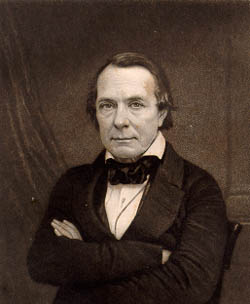Expulsion of the Cherokees
|

President Mirabeau B.
Lamar |
President Mirabeau B. Lamar, who took office at the end of
1838, had a very different attitude towards Indians than did
Sam Houston. Lamar believed that the Indians had no integrity;
thus, there was no possibility of peaceful negotiation or
co-existence. The only solution to the violent clashes between
whites and Indians was to rid Texas of the Indians--permanently.
Lamar spoke for the majority of white Texans, who had wearied
of Sam Houston's peace efforts. Houston had achieved little
cooperation with the Texas Congress, which ratified almost
none of his treaties. By contrast, Congress was quick to pass
Lamar's frontier defense bills and appropriated more than
a million dollars to pay for troops, military roads, and forts.
Relations with the Cherokees
were the first to come to a boil. Lamar hoped to convince
the Cherokees to leave Texas peacefully, but he made it clear
that if they did not leave, they would face unmerciful military
action. Lamar sent a commission of leading hard-liners, including
David G. Burnet, Thomas J. Rusk, and Albert Sidney Johnston,
to negotiate the removal of the tribe to the Arkansas territory.
He also deployed about 900 army regulars, volunteers, and
militia to East Texas.
Fearful of being attacked, the Cherokees retreated to a fortified
Delaware village near Camp Jackson. On July 15, 1839, several
hundred warriors under Chief Bowl engaged the Texans near
present-day Tyler. In the initial battle, the Indians were
defeated, losing eighteen men to the Texans' three. The next
day, the Texans pursued the retreating Indians and inflicted
more than 100 casualties, Chief Bowl among them. They also
burned the Indian villages and chased the Indians across the
Red River into neighboring Indian Territory (Oklahoma). In
the aftermath, many of the weaker or more peaceful tribes
in East Texas were also forced to relocate.
| |
Lamar
Declares, "No Compromise," 1838
Most Texans agreed with Lamar that Indians and whites
could not live together as neighbors. Lamar instituted
a hard-line policy that he hoped would result in the
expulsion or extermination of Indians from Texas.
House Journal, Third Congress of the
Republic of Texas.
|
"The
Cherokee Can No Longer Remain Among Us"
In this letter to Shawnee
chief John Linney, Lamar denounces the Cherokee alliance
with the Mexicans and urges the Shawnees to remain
neutral in the event of war. The Shawnees kept the
peace but were eventually forced to leave Texas, though
they received some compensation for the crops and
property they were forced to leave behind.
Texas Indian Papers Volume 1, #35.
Mirabeau B. Lamar to John Linney, May 1839. |
|
| |
Lamar
Orders the Cherokee Removal, 1839
After discovering evidence of a Mexican plot to ally
with the Indians to overthrow the Republic of Texas,
Lamar abandoned any efforts to find a peaceful solution.
He sent troops to occupy the Neches Saline area and
notified Chief Bowl that his people would be removed
beyond the Red River, by force if necessary. The Cherokees
decided to fight.
Texas Indian Papers Volume 1, #36.
Mirabeau B. Lamar to David G. Burnet, Albert Sidney
Johnston, Thomas J. Rusk, I.W. Burton, and James S.
Mayfield; June 27, 1839. |
Kelsey Douglass to Secretary of War Albert Sidney
Johnston, 1839
In July 1839, Texas congressman Kelsey H. Douglass
was put in command of approximately 500 troops and
ordered to remove the Indians to Arkansas Territory.
On July 15, the final peace negotiations failed, and
Douglass marched on the Cherokee village.
Mirabeau B. Lamar Papers # 1373. Kelsey
Douglass to Albert Sidney Johnston, July 17, 1839.
|
|
| 
|
Relocation
of the Alabamas and Coushattas, 1840
The defeat and expulsion of the Cherokees changed
life for many other tribes in Texas. By 1841, East
Texas was almost entirely cleared of Indians. The
Alabamas
and Coushattas were exceptions. A peaceful tribe
who had aided the Texans during the Runaway Scrape,
they were granted two leagues of land along the Trinity
River.
Texas Indian Papers Volume 1, #94.
Thomas G. Stubblefield to Secretary of State Abner
L. Lipscomb, November 2, 1840. |
In This Section:
Expulsion of the Cherokees -The
Comanche War -
Treaty Negotiations
- Trade
Next Section
- Table of Contents
- HOME
|
